Fatigue Properties of Ultra-Fine Grained Al-Mg-Si Wires with Enhanced Mechanical Strength and Electrical Conductivity
Abstract
1. Introduction
2. Materials and Methods
3. Results and Discussion
3.1. Effect of Complex SPD Processing on Microstructure
3.2. Effect of SPD Processing on Electrical Conductivity of the Wires
3.3. Effect of Complex SPD Processing on the Mechanical Properties and Fatigue Resistance
3.4. About Potential Application of the Developed Processing Route
4. Conclusions
- The ECAP-C processing for six passes at 130 °C results in significant grain refinement and formation of the homogeneous microstructure with an average grain size of 1.7 µm, a significant fraction of ultra-fine grains and dominating low angle grain boundaries. Artificial aging at 170 °C for 10 h leads to the formation of rod-shaped metastable β′-nanoprecipitates in the grain interior and reduction of dislocation density. Final CD results in the formation of fiber-type grains elongated along the drawing axis, having a width of 200–300 nm with spherical nano-precipitates and dominating high angle grain boundaries. The microstructure of the T81 processed alloy is characterized by coarser fiber-type grains (about 1 µm) and needle-type metastable β″-nanoprecipitates.
- The ECAP-C processing of the alloy increases its electrical conductivity, which is further enhanced during artificial aging due to the purification of the Al matrix from solute atoms. Despite a slight reduction of electrical conductivity after CD, the SPD processed wire still demonstrates significantly higher electrical conductivity compared to the conventional T81 processed Al 6101 commercial alloy.
- The SPD processed Al 6101 wire shows significantly higher mechanical strength and fatigue resistance (by ~20%) and similar levels of ductility compared to the conventional T81 processed counterpart.
- The improved combination of mechanical strength, fatigue resistance and electrical conductivity of the SPD processed Al 6101 wire in comparison with the T81 processed one is related to the finer grain size and spherical β′-nanoprecipitates. Commercialization of the developed technology for manufacturing of UFG wires could lead to a significant reduction of energy loss in the transmission of overheard power lines. Another benefit is related to the lower cost of construction and the service of the power lines due to larger spacing between fermas.
Author Contributions
Funding
Acknowledgments
Conflicts of Interest
References
- Valiev, R.Z.; Zhilyaev, A.P.; Langdon, T.G. Bulk Nanostructured Materials: Fundamentals and Applications; John Wiley & Sons: Hoboken, NJ, USA, 2014; p. 456. [Google Scholar]
- Sabirov, I.; Murashkin, M.Y.; Valiev, R.Z. Nanostructured aluminium alloys produced by severe plastic deformation: New horizons in development. Mater. Sci. Eng. A 2013, 560, 1–24. [Google Scholar] [CrossRef]
- Markushev, M.V.; Murashkin, M.Y. Mechanical properties of submicrocrystalline Al alloys processed by equal-channel angular pressing. Phys. Met. Metall. 2000, 90, 506–515. [Google Scholar]
- Roven, H.J.; Nesboe, H.; Werenskiold, J.C.; Seibert, T. Mechanical properties of aluminum alloys processed by SPD: Comparison of different alloy systems and possible product areas. Mater. Sci. Eng. A 2005, 410–411, 426–429. [Google Scholar] [CrossRef]
- Lyakishev, N.P.; Alymov, M.I.; Dobatkin, S.V. Structural bulk nanomaterials. Russ. Metall. 2003, 3, 191–202. [Google Scholar]
- Dobatkin, S.V.; Zakharov, V.V.; Vinogradov, A.Y.; Kitagava, N.; Krasilnikov, N.A.; Rostova, T.D.; Bastrash, E.N. Nanocrystalline structure in Al-Mg-Sc alloys by severe plastic deformation. Russ. Metall. 2006, 6, 533–540. [Google Scholar] [CrossRef]
- Zhao, Y.; Liao, X.; Cheng, S.; Ma, E.; Zhu, Y. Simultaneously increasing the ductility and strength of nanostructured alloys. Adv. Mater. 2006, 18, 2280–2283. [Google Scholar] [CrossRef]
- Horita, Z.; Ohashi, K.; Fujita, T.; Kaneko, K.; Langdon, T.G. Achieving high strength and high ductility in precipitation-hardened alloys. Adv. Mater. 2005, 17, 1599–1603. [Google Scholar] [CrossRef]
- Markushev, M.V.; Bampton, C.C.; Murashkin, M.Y.; Hardwick, D.A. Structure and properties of ultra-fine grained Al alloys produced by severe plastic deformation. Mater. Sci. Eng. A 1997, 234–236, 927–931. [Google Scholar] [CrossRef]
- Murashkin, M.; Sabirov, I.; Kazykhanov, V.; Bobruk, E.; Dubravina, A.; Valiev, R.Z. Enhanced mechanical properties and electrical conductivity in ultra-fine grained Al alloy processed via ECAP-PC. J. Mater. Sci. 2013, 48, 4501–4509. [Google Scholar]
- Valiev, R.Z.; Murashkin, M.Y.; Sabirov, I. A nanostructural design to produce high-strength Al alloys with enhanced electrical conductivity. Scr. Mater. 2014, 76, 13–16. [Google Scholar] [CrossRef]
- Vinogradov, A.Y.; Khasimoto, S. Fatigue in ultrafine-grained materials processed by equal-channel angular pressing. Russ. Metall. 2004, 1, 42–51. [Google Scholar]
- Estrin, Y.; Vinogradov, A. Fatigue behaviour of light alloys with ultrafine grain structure produced by severe plastic deformation: An overview. Int. J. Fatigue 2010, 32, 898–907. [Google Scholar] [CrossRef]
- Estrin, Y.; Vinogradov, A. Extreme grain refinement by severe plastic deformation: A wealth of challenging science. Acta Mater. 2013, 61, 782–817. [Google Scholar] [CrossRef]
- Höppel, W.; Kautz, M.; Murashkin, M.Y.; Xu, C.; Langdon, T.G.; Valiev, R.Z.; Mughrabi, H. An overview: Fatigue Behavior of Ultrafine-Grained Metals and Alloys. Int. J. Fatigue 2006, 28, 1001–1010. [Google Scholar] [CrossRef]
- Höpel, H.W.; Göken, M. Fatigue Behavior in Nanostructured Metals. In Nanostructured Metals and Alloys: Processing, Microstructure, Mechanical Properties and Applications; Whang, S.H., Ed.; Woodhead Publishing Limited: Suite, PA, USA, 2011; pp. 507–541. [Google Scholar]
- Mughrabi, H.; Höppel, H.W.; Kautz, M. Fatigue and microstructure of ultra-fine grained metals produced by severe plastic deformation. Scr. Mater. 2004, 51, 807–812. [Google Scholar] [CrossRef]
- Malekjani, S.; Hodgson, P.D.; Cizek, P.; Sabirov, I.; Hilditch, T.B. Cyclic deformation response of UFG 2024 Al alloy. Int. J. Fatigue 2011, 33, 700–709. [Google Scholar] [CrossRef]
- Canadinc, D.; Maier, H.J.; Gabor, P.; May, J. On the cyclic deformation response of ultrafine-grained Al–Mg alloys at elevated temperatures. Mater. Sci. Eng. A 2008, 496, 114–120. [Google Scholar] [CrossRef]
- Vinogradov, A.; Washikita, A.; Kitagawa, K.; Kopylov, V.I. Fatigue life of fine-grain Al-Mg-Sc alloys produced by equal-channel angular pressing. Mater. Sci. Eng. A 2003, 349, 318–326. [Google Scholar] [CrossRef]
- Chung, C.S.; Kim, J.K.; Kim, H.K.; Kim, W.J. Improvement of high-cycle fatigue life in a 6061 Al alloy produced by equal channel angular pressing. Mater. Sci. Eng. A 2002, 337, 39–44. [Google Scholar] [CrossRef]
- Lapovok, R.; Loader, C.; Dalla Torre, F.H.; Semiatin, S.L. Microstructure evolution and fatigue behavior of 2124 aluminum processed by ECAE with back pressure. Mater. Sci. Eng. A 2006, 425, 36–46. [Google Scholar] [CrossRef]
- Malekjani, S.; Hodgson, P.D.; Cizek, P.; Hilditch, T.B. Cyclic deformation response of ultra-fine pure Al. Acta Mater. 2011, 59, 5358–5367. [Google Scholar] [CrossRef]
- Murashkin, M.; Sabirov, I.; Prosvirnin, D.; Ovid’ko, I.; Terentiev, V.; Valiev, R.; Dobatkin, S. Fatigue behavior of an ultrafine-grained Al-Mg-Si alloy processed by high-pressure torsion. Metals 2015, 5, 578–590. [Google Scholar] [CrossRef]
- Kiessling, F.; Nefzger, P.; Nolasco, J.F.; Kaintzyk, U. Overhead Power Lines: Planning, Design, Construction; Springer: Berlin, Germany, 2003. [Google Scholar]
- Segal, V.M. Materials processing by simple shear. Mater. Sci. Eng. A 1995, 147, 157–164. [Google Scholar] [CrossRef]
- Raab, G.J.; Valiev, R.Z.; Lowe, T.C.; Zhu, Y.T. Continuous processing of ultrafine grained Al by ECAP-Conform. Mater. Sci. Eng. A. 2004, 382, 30–34. [Google Scholar] [CrossRef]
- Valiev, R.Z.; Langdon, T.G. Principles of equal-channel angular pressing as a processing tool for grain refinement. Prog. Mater. Sci. 2006, 51, 881–981. [Google Scholar] [CrossRef]
- Murashkin, M.; Medvedev, A.; Kazykhanov, V.; Krokhin, A.; Raab, G.; Enikeev, N.; Valiev, R.Z. Enhanced Mechanical Properties and Electrical Conductivity in Ultrafine-Grained Al 6101 Alloy Processed via ECAP-Conform. Metals 2015, 5, 2148–2164. [Google Scholar] [CrossRef]
- Lutterotti, M.; Matthies, S.; Wenk, H.R. MAUD (Material Analysis Using Diffraction): A user friendly Java program for Rietveld Texture Analysis and more. In Proceeding of the 12th International Conference on Textures of Materials (ICOTOM-12), Montreal, QC, Canada, 9–13 August 1999; p. 1599. [Google Scholar]
- Williamson, L.K.; Smallman, R.E. III. Dislocation densities in some annealed and cold-worked metals from measurements on the X-ray Debye-Scherrer spectrum. Philos. Mag. 1956, 1, 34–45. [Google Scholar] [CrossRef]
- International Electrotechnical Commission (IEC). IEC 60468: Method of Measurement of Resistivity of Metallic Materials; IEC: Geneva, Switzerland, 1974. [Google Scholar]
- Mondolfo, L.F. Aluminum Alloys: Structure and Properties; Butterworth: Oxford, UK, 1976; p. 971. [Google Scholar]
- Ungar, T.; Tichy, G.; Gubicza, J.; Hellmig, R.J. Correlation between subgrains and coherently scattering domains. Powder Diffr. 2005, 20, 366–376. [Google Scholar] [CrossRef]
- Rositter, P.L. The Electrical Resistivity of Metals and Alloys; Cambridge University Press: Cambridge, UK, 2003. [Google Scholar]
- Suresh, S. Fatigue of Materials; Cambridge University Press: Cambridge, UK, 1998; p. 679. [Google Scholar]
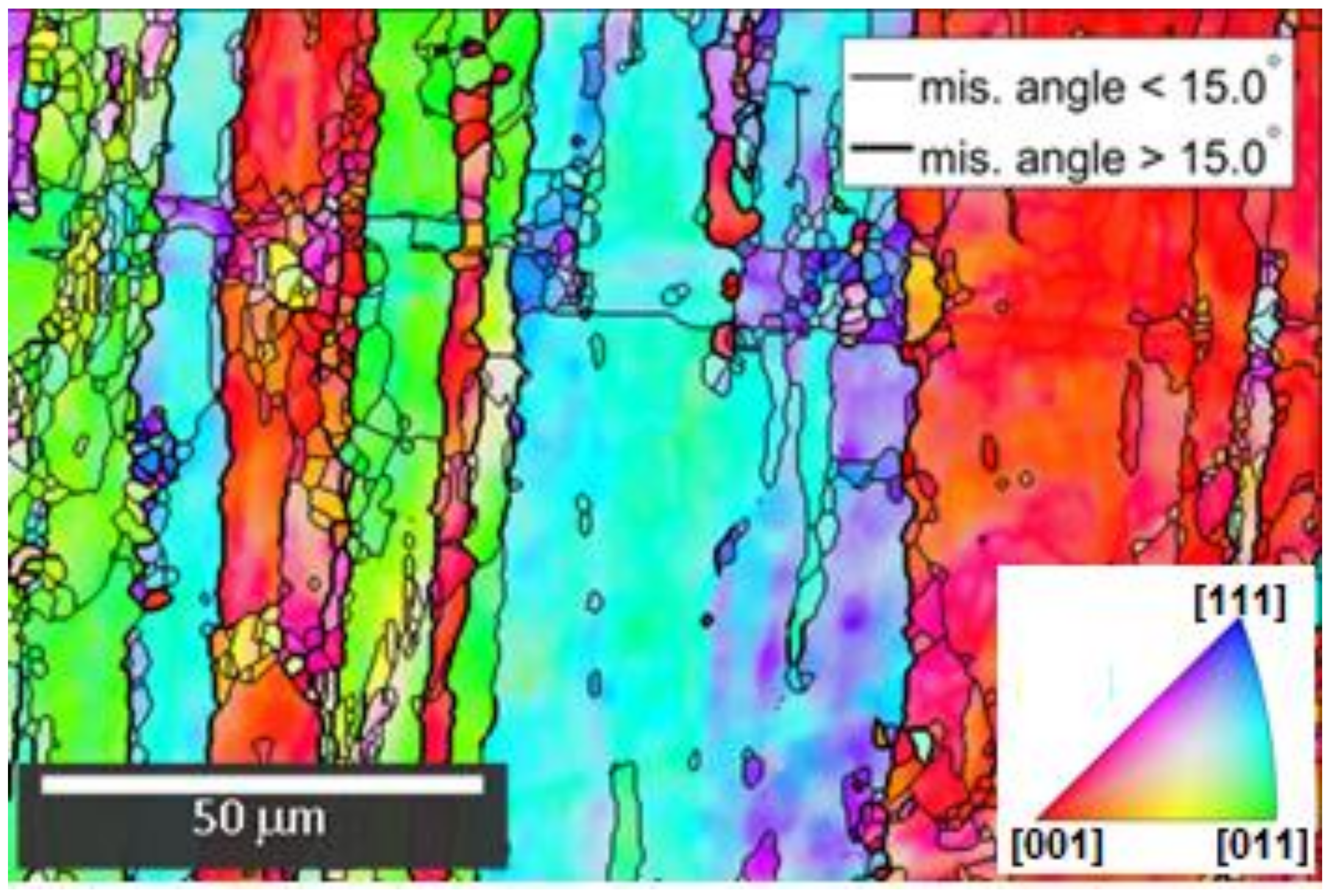
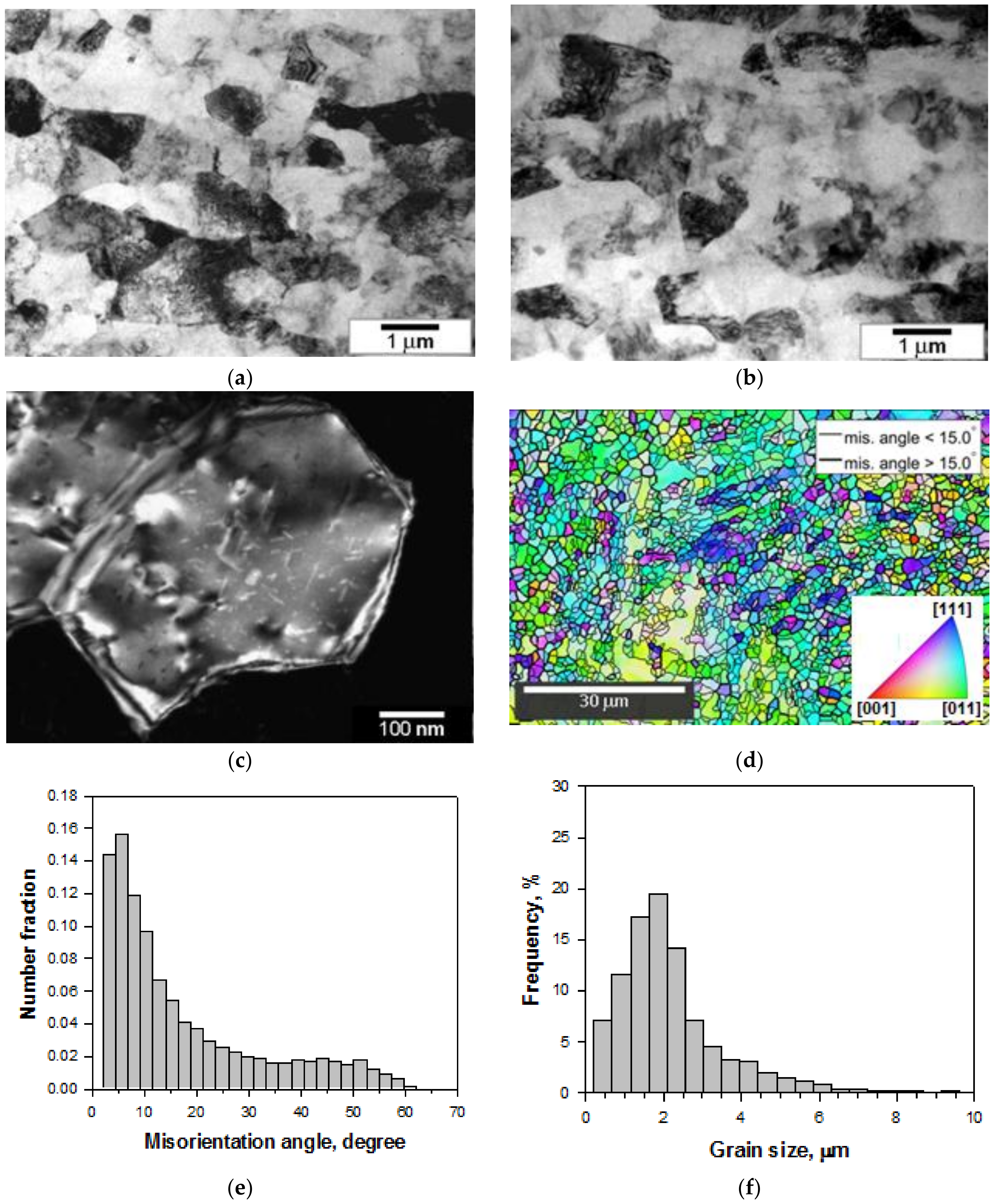
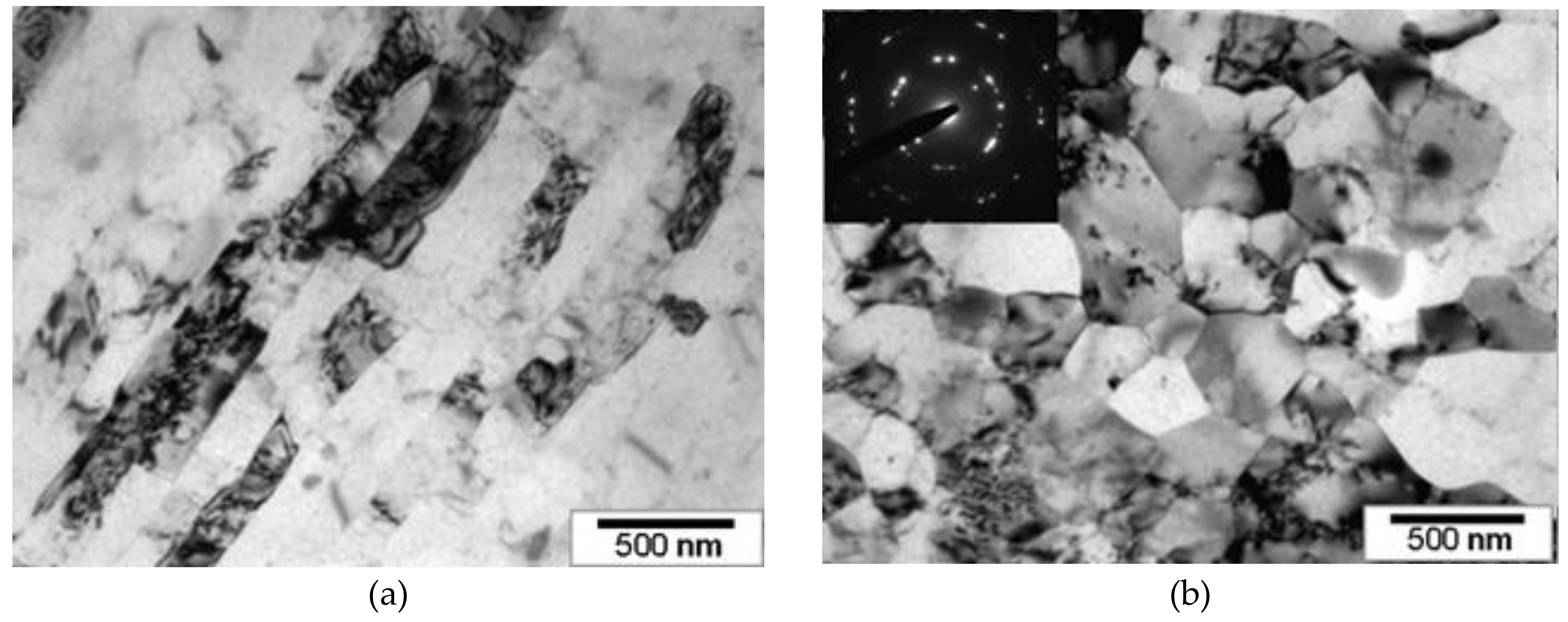




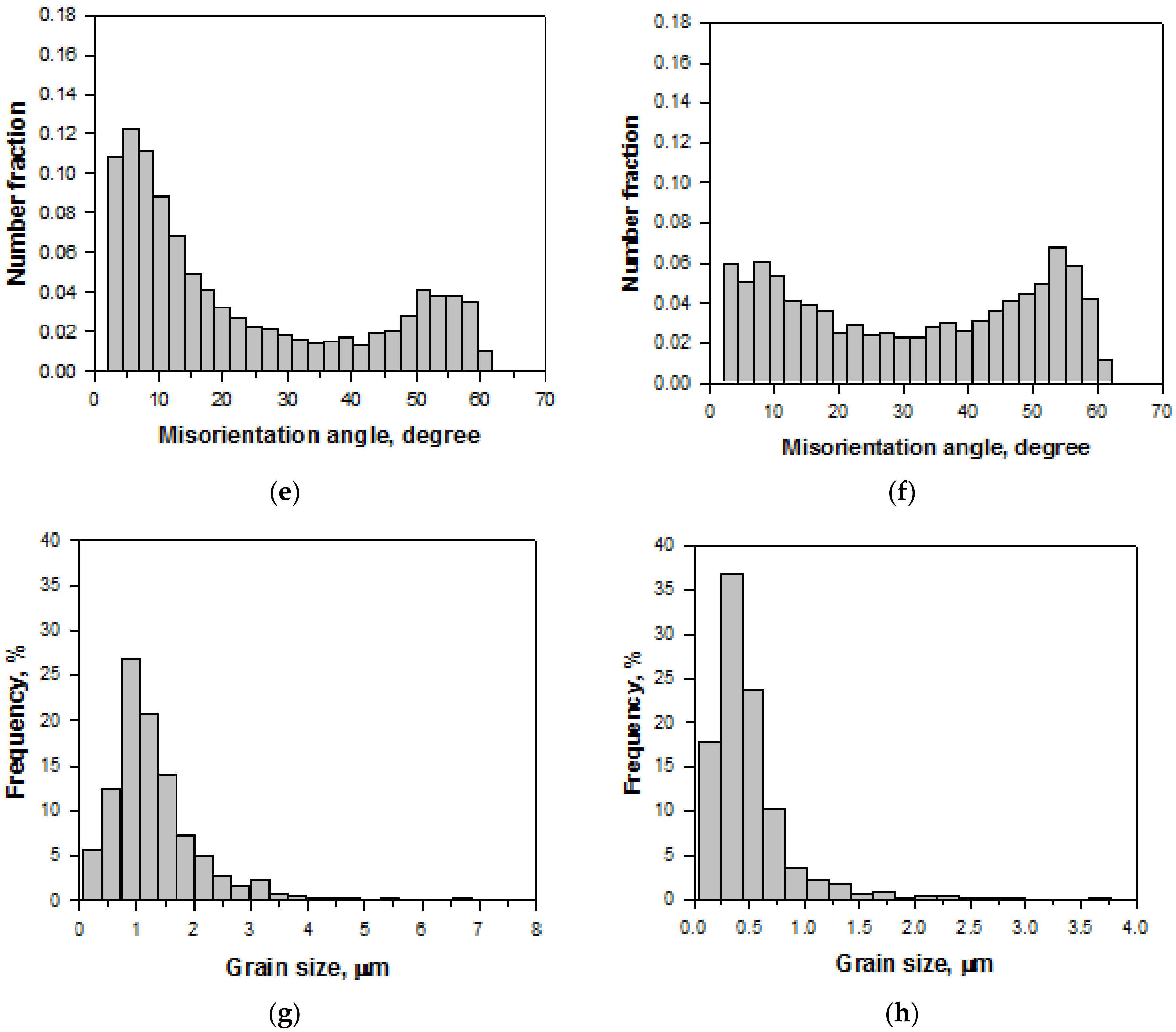
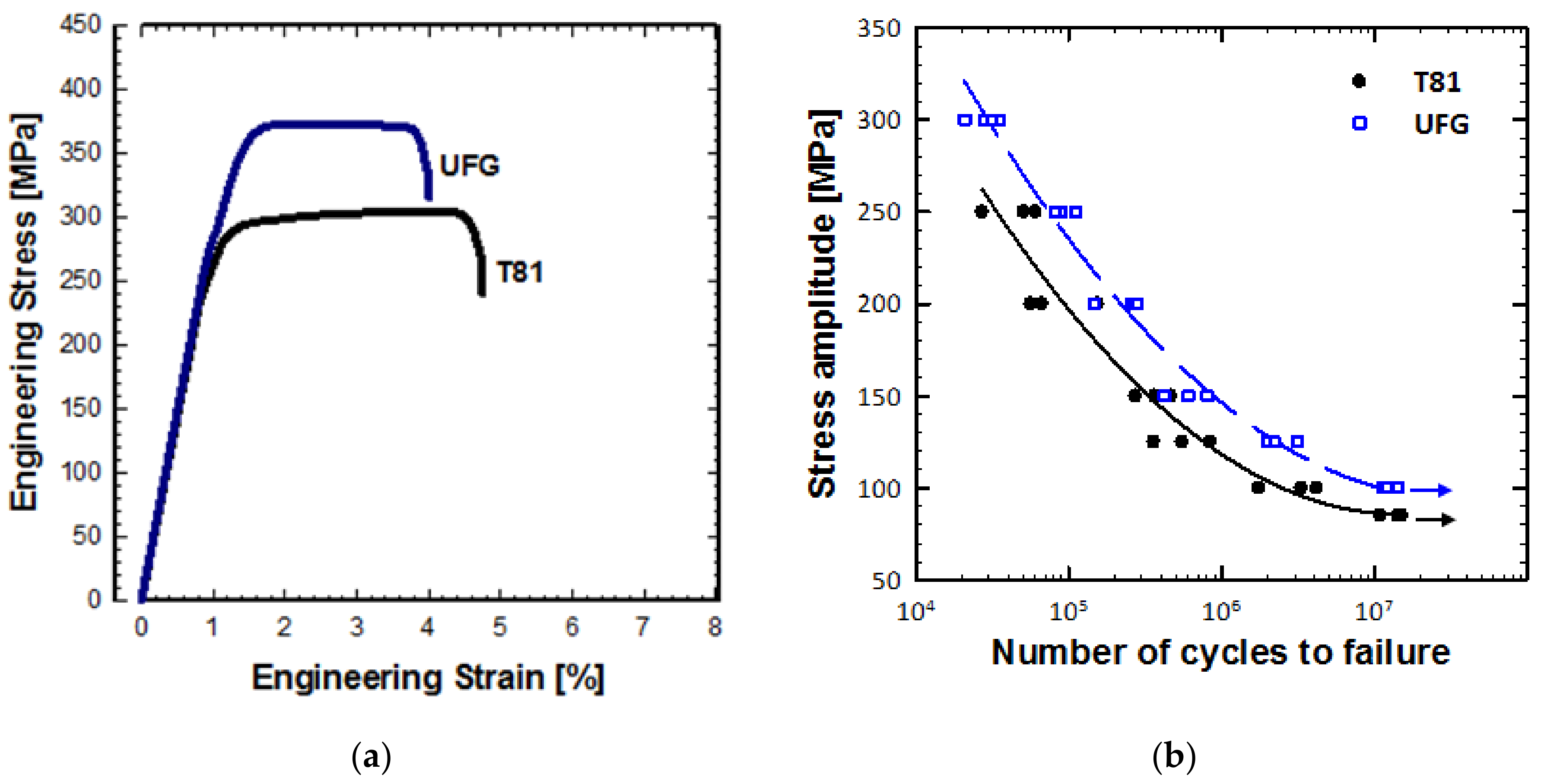
| State/Treatment | Dhkl, [nm] | <ε2>1/2, [%] | а, [Å] | ρ, [m−2] |
|---|---|---|---|---|
| Initial state—T1 (this work) | - | - | 4.0531 ± 0.0008 | - |
| 6 cycles ECAP-Cat 130 °C | 165 ± 20 | 0.110 ± 0.024 | 4.0520 ± 0.0002 | 8.0 × 1013 |
| ECAP-C + AAat 170 °C | 188 ± 13 | 0.067 ± 0.031 | 4.0508 ± 0.0004 | 4.3 × 1013 |
| ECAP-C + AA + CD | 84 ± 1 | 0.097 ± 0.008 | 4.0507 ± 0.0003 | 1.4 × 1014 |
| Conventional TMT T81 | 81 ± 4 | 0.054 ± 0.005 | 4.0516 ± 0.0002 | 9.5 × 1013 |
| State/Treatment | σ0.2 [MPa] | σUTS [MPa] | δ [%] | Resistivity [nΩm] | IACS [%] | σR [MPa] | σR/ σUTS | Ref. |
|---|---|---|---|---|---|---|---|---|
| Initial state—T1 1 | 120 ± 1 | 195 ± 2 | 22.4 ± 0.4 | 34.23 | 50.4 | - | - | [29] |
| 6 cycles ECAP-C at 130 °C | 282 ± 8 | 308 ± 9 | 15.1 ± 0.6 | 32.42 | 53.2 | - | - | |
| ECAP-C + AA at 170 °C | 291 ± 10 | 304 ± 3 | 15.0 ± 2 | 30.20 | 57.1 | - | - | |
| ECAP-C + AA + CD | - | 364 ± 9 | 3.5 ± 0.2 | 30.55 | 56.4 | 100 | 0.27 | This work |
| Convention T81 | - | 309 ± 7 | 4.1 ± 0.3 | 31.87 | 54.1 | 80 | 0.26 |
© 2018 by the authors. Licensee MDPI, Basel, Switzerland. This article is an open access article distributed under the terms and conditions of the Creative Commons Attribution (CC BY) license (http://creativecommons.org/licenses/by/4.0/).
Share and Cite
Medvedev, A.; Arutyunyan, A.; Lomakin, I.; Bondarenko, A.; Kazykhanov, V.; Enikeev, N.; Raab, G.; Murashkin, M. Fatigue Properties of Ultra-Fine Grained Al-Mg-Si Wires with Enhanced Mechanical Strength and Electrical Conductivity. Metals 2018, 8, 1034. https://doi.org/10.3390/met8121034
Medvedev A, Arutyunyan A, Lomakin I, Bondarenko A, Kazykhanov V, Enikeev N, Raab G, Murashkin M. Fatigue Properties of Ultra-Fine Grained Al-Mg-Si Wires with Enhanced Mechanical Strength and Electrical Conductivity. Metals. 2018; 8(12):1034. https://doi.org/10.3390/met8121034
Chicago/Turabian StyleMedvedev, Andrey, Alexander Arutyunyan, Ivan Lomakin, Anton Bondarenko, Vil Kazykhanov, Nariman Enikeev, Georgy Raab, and Maxim Murashkin. 2018. "Fatigue Properties of Ultra-Fine Grained Al-Mg-Si Wires with Enhanced Mechanical Strength and Electrical Conductivity" Metals 8, no. 12: 1034. https://doi.org/10.3390/met8121034
APA StyleMedvedev, A., Arutyunyan, A., Lomakin, I., Bondarenko, A., Kazykhanov, V., Enikeev, N., Raab, G., & Murashkin, M. (2018). Fatigue Properties of Ultra-Fine Grained Al-Mg-Si Wires with Enhanced Mechanical Strength and Electrical Conductivity. Metals, 8(12), 1034. https://doi.org/10.3390/met8121034





